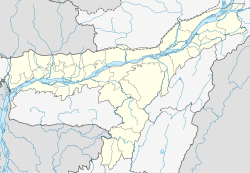History
Assam Bengal Railway was incorporated in 1892 to serve British-owned tea plantations in Assam. [1] The railway line from Chittagong to Badarpur was opened to traffic in 1898. [2] In 1942 the management of Assam Bengal Railway was transferred to the Govt of India. It was amalgamated with the state managed Eastern Bengal Railway and designated as Assam Bengal Railway . [1]
On 1 January 1942 the Assam Bengal Railway combined with the Eastern Bengal Railway to form the Bengal and Assam Railway. [3] [4] At time of the independence of India in 1947, Bengal–Assam Railway was split up and the portion of the system, about 2,603.92 km long which fell within the boundary of erstwhile East Pakistan was named as Eastern Bengal Railway, the control remaining with the central Government of Pakistan. Later, with the effect from 1 February 1961, Eastern Bengal Railway was renamed as Pakistan Railway. [3] at the year 1958 Northeast Frontier Railways created and Badarpur Junction came under it.
Successors
With the partition of India in 1947, portions of the Assam Bengal Railway which lay in Assam and the Indian part of North Bengal became Assam Railway. North Eastern Railway was formed in 1952 by amalgamating Assam Railway with Oudh Tirhut Railway and Fatehgarh district of Bombay, Baroda and Central India Railway. Northeast Frontier Railway was carved out of North Eastern Railway in 1958. [1] [5]
The portion of the system which fell within the boundary of erstwhile East Pakistan was named as Eastern Bengal Railway. On 1 February 1961, Eastern Bengal Railway was renamed as Pakistan Railway and in 1962 it became Pakistan Eastern Railway . [6] With the emergence of Bangladesh, it became Bangladesh Railway. [7]
After the independence of Pakistan on 15 August 1947 the broad-gauge portion of the Assam Bengal Railway, lying in India was added to the East Indian Railway and the metre-gauge portion became the Assam Railway, [8] with its headquarters at Pandu. On 14 April 1952, the 2857 km-long Assam Railway and the Oudh and Tirhut Railway were amalgamated to form one of the six newly carved zones of the Indian Railways: the North Eastern Railway zone. [9] [10] On the same day, the reorganised Sealdah division of the erstwhile Bengal Assam Railway (which was added to the East Indian Railway earlier) was amalgamated with the Eastern Railway. [11]
This page is based on this
Wikipedia article Text is available under the
CC BY-SA 4.0 license; additional terms may apply.
Images, videos and audio are available under their respective licenses.



